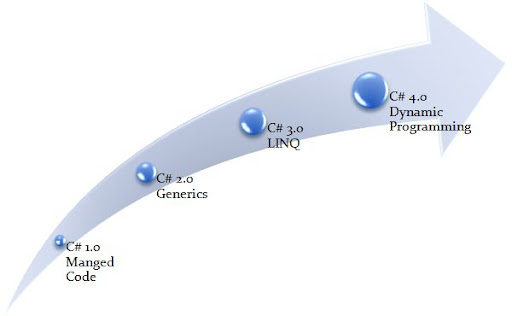The Evolution Of C#
 The first release of C# (C# 1.0) was all about building a new language for managed code that appealed, mostly, to C++ and Java programmers.
The first release of C# (C# 1.0) was all about building a new language for managed code that appealed, mostly, to C++ and Java programmers.
The second release (C# 2.0) was mostly about adding what wasn’t time to built into the 1.0 release. The main feature for this release was Generics.
The third release (C# 3.0) was all about reducing the impedance mismatch between general purpose programming languages and databases. To achieve this goal, several functional programming features were added to the language and LINQ was born.
Going forward, new trends are showing up in the industry and modern programming languages need to be more:
- Declarative
With imperative languages, although having the eye on the what, programs need to focus on the how. This leads to over specification of the solution to the problem in hand, making next to impossible to the execution engine to be smart about the execution of the program and optimize it to run it more efficiently (given the hardware available, for example).
Declarative languages, on the other hand, focus only on the what and leave the how to the execution engine. LINQ made C# more declarative by using higher level constructs like orderby and group by that give the execution engine a much better chance of optimizing the execution (by parallelizing it, for example).
- Concurrent
Concurrency is hard and needs to be thought about and it’s very hard to shoehorn it into a programming language. Parallel.For (from the parallel extensions) looks like a parallel for because enough expressiveness has been built into C# 3.0 to allow this without having to commit to specific language syntax.
- Dynamic
There was been lots of debate on which ones are the better programming languages: static or dynamic. The fact is that both have good qualities and users of both types of languages want to have it all.
All these trends require a paradigm switch. C# is, in many ways, already a multi-paradigm language. It’s still very object oriented (class oriented as some might say) but it can be argued that C# 3.0 has become a functional programming language because it has all the cornerstones of what a functional programming language needs. Moving forward, will have even more.
Besides the influence of these trends, there was a decision of co-evolution of the C# and Visual Basic programming languages. Since its inception, there was been some effort to position C# and Visual Basic against each other and to try to explain what should be done with each language or what kind of programmers use one or the other. Each language should be chosen based on the past experience and familiarity of the developer/team/project/company and not by particular features.
In the past, every time a feature was added to one language, the users of the other wanted that feature too. Going forward, when a feature is added to one language, the other will work hard to add the same feature. This doesn’t mean that XML literals will be added to C# (because almost the same can be achieved with LINQ To XML), but Visual Basic will have auto-implemented properties.
Most of these features require or are built on top of features of the .NET Framework and, the focus for C# 4.0 was on dynamic programming. Not just dynamic types but being able to talk with anything that isn’t a .NET class.
Also introduced in C# 4.0 is co-variance and contra-variance for generic interfaces and delegates.
Stay tuned for more on the new C# 4.0 features.